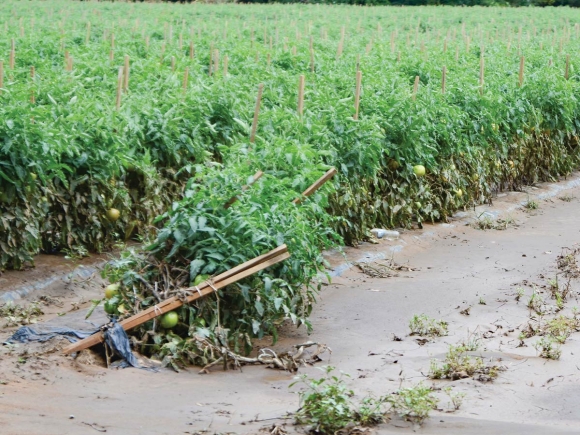Flood of peppers: Fred strips fields prime for harvest
 Due to food safety laws, even crops like these tomatoes in Cruso, which look to be relatively intact after the floodwaters receded, will have to be destroyed. This is due to possible contamination in the soil and water. Aug. 19. Holly Kays photo
Due to food safety laws, even crops like these tomatoes in Cruso, which look to be relatively intact after the floodwaters receded, will have to be destroyed. This is due to possible contamination in the soil and water. Aug. 19. Holly Kays photo
Rain was coming down hard as Gary Griffith surveyed his fields in Bethel, around 4 p.m. on Tuesday, Aug. 17. Harvest season was in full swing, and before he went home to Ratcliff Cove, he wanted to make sure his 15 acres of peppers and cucumbers growing along the Pigeon River would make it through the storm.
“I thought I had a glimpse that we were going to be OK, because it hadn’t flooded yet,” Griffith said.
He reached his conclusion too early. In the hour after Griffith left the farm, the river surged, covering the crops and sweeping away the tens of thousands of green peppers that would become the unofficial symbol of a historic flood . When the water receded, the peppers were everywhere — washed up on riverbanks, speared on shrubs and smashed on roads for miles. Their sharp, earthy scent filled the air as he and his workers assessed the damage Wednesday morning.
The scent was a tangible reminder of the labor, the seed, the fertilizer and the years of expertise that went into producing a crop that Griffith will never be able to harvest. By the time Tropical Storm Fred arrived, he’d picked only about 40% of the year’s produce from his 12 acres of peppers, and about a quarter of the harvest on his 3 acres of cucumbers.
Griffith said the loss exacerbated a struggle that’s been getting worse for years, accelerating with the pandemic’s arrival.
“Since COVID started or even before that, the market price that farmers get versus what the end product is, is ridiculous,” he said. “The farmers are really in danger, because why would we want to keep going when we’re not making any money?”
Related Items
A catastrophe like Fred makes the question more urgent.
Griffith has insurance that will cover some of his crop loss, but there’s also an additional $50,000 to $75,000 in damage that insurance would never cover. It’s the things people don’t see — the flooded truck that will need to be replaced, the broken stakes, the pervasive layer of mud that will have to be bulldozed away before the field can drain properly again.
Griffith is 62, and as he adds up the numbers, he’s not sure what his next move should be. Is it smart to go into debt to rebuild when retirement is so close at hand?
“To continue on, I’ve got a big outlay for next year, and the question is, why would I want to do that?” he said.

A layer of green peppers, likely from Gary Griffith’s farm in Bethel, covers the Pigeon River bank on the downstream side of the bridge over Canton’s Main Street. Holly Kays photo
From trout to tomatoes, farmers struggle
Griffith is not the only farmer making that calculation. Glen Johnson, co-owner of J.W. Johnson Tomato Company , said he works with seven tomato farmers in Haywood County, and of those seven, five saw their fields completely submerged when the floodwaters ravaged Cruso.
Some crops are flattened. Others, once the water receded, retained some mud splatters but appeared to be otherwise healthy. But that doesn’t matter, Johnson said — if floodwater douses it, it’s unsellable.
“Even crops that might look good a day or two after, you can’t harvest them when the water gets in there because you don’t know what’s in the water, what’s in the soil,” he said. “All that stuff that’s floated downriver might have contaminated it. Everything that had a certain amount of water on it to a certain height, it’s just deemed unharvestable.”
Financially, he said, the loss will be “devastating” for farmers.
Vegetable farmers aren’t the only growers whose operations were decimated. Sunburst Trout Farms , which supplies fresh fish to buyers across the region, lost 78,000 pounds of trout as floodwaters jumped a berm designed to protect its farm in Cruso, carrying away the trout and destroying the raceway — a complete loss.
“One of our employees got caught on Tuesday out in Cruso, because it was his turn to watch over the fish at that farm, and it happened so fast he couldn’t leave,” said Sunburst’s marketing director Anna Eason. “We have a camper that we keep out there for when we have to watch the fish if it rains too much, but he luckily was able to pull the camper out before the water overtook the farm.”
Luckily, she said, because that’s where he ended up staying the night.
The flood didn’t destroy the business itself because Sunburst also has a trout farm at Lake Logan, which received only minor damage, as well as a third location that did not have any trout in it at the time of the flood. However, the fallout from Tropical Storm Fred will impact Sunburst for years to come. Between the fish and the cost to rebuild the farm, damage is estimated at more than $560,000, Eason said.
“That farm was pretty important to our survival,” Eason said of the Cruso location. “The cost we estimate to rebuild it is $150,000, but it could be more because we just don’t know — because of the fact that now everybody is going to be rebuilding, and time and costs start to go up when that happens, and the lack of workers as it is in most areas.”
While farmers in Bethel, Cruso and Canton — the county’s premier agricultural district — were the hardest hit as a result of the storm, producers across the county saw their operations impacted, said Haywood County Cooperative Extension Director Bill Skelton.
“Even up on the mountainsides, culverts were blocked and the water overwashed them and washed out fences,” he said. “It impacted a huge number of farmers across the country, not just in Bethel and Cruso. Some were hard hit, others less so.”
Help a ‘wait and see game’
Recovery will depend heavily on what kind of assistance farmers can get to help recoup their losses and restore demolished infrastructure. And right now, that’s an open question.
“It’s a wait and see game to see what Congress passes,” said Paula Edwards, Haywood County Executive Director for the Farm Service Agency. “It’s not like the good old days of when we had ad hoc disaster programs. Those are pretty much a thing of the past. We are just waiting on the various designations and just going from there.”
Most federal aid is dependent on a presidential disaster declaration coupled with action from Congress to appropriate aid money. It will take some time for that process to play out. In the meantime, said Edwards, farmers affected by the storm should take dated photos of all losses and impacts before starting cleanup.
In a flood situation like this, she said, federal money will also cover some percentage of crop, livestock and fish losses — but the exact parameters depend on what program Congress passes, what is included in the current Farm Bill and a variety of other factors. There’s no way to know for certain, but Edwards has hope that Congress could roll out a major nationwide assistance program given that western states are dealing with drought and fires even as the East grapples with flooding.
Farmers are required to carry catastrophic insurance, purchased through the FSA, which covers a portion of the cost they shouldered earlier in the season to put seed in the ground and fertilize the soil. But neither catastrophic insurance nor expected federal aid aims to make up for the money the farmers hoped to reap at harvest — for many, their earnings for the entire year.
Some farmers may carry a higher level of crop insurance that covers more types of losses, but such insurance is expensive, and most farmers try to save money by gambling that they won’t need the benefits, said Randy Rogers, a retired agriculture loan officer with Carolina Farm Credit. Then, when a catastrophic event happens, those farmers aren’t able to pay back the operating loan they took out at the start of the season to cover upfront production costs. That operating loan is then rolled into a longer-term capital loan.
“The next year, when he borrows money he’s going to have to pay back that money plus one-fifth of the loss from the year before, so it really creates a burden when you have a crop loss like that,” Rogers said.
It’s a serious situation, Johnson said, and not just for the farmers whose fields were flooded.
“A lot of farmers look at each other as competition, but you can’t really look at it that way,” he said. “The more produce you have in an area the better, because then you can supply larger accounts. You can promote more. You have more trucks in the area. If you just have a few little tiny farms in the middle of nowhere, you’re not going to succeed, because you need that volume to supply a lot of these larger accounts in order to get the better pricing and the better end user business.”
But dire as Fred’s fallout may be, even farmers who saw their entire year’s earnings destroyed overnight say their story isn’t the most important one right now.
“What I’ve lost is money, and that comes and goes, but what other people lost are lives and homes and everything they’ve got,” said Griffith. “So I’m blessed and very fortunate.”
Ag hotline activated
A hotline aiming to connect farmers impacted by Tropical Storm Fred with resources is now active daily from 8 a.m. to 5 p.m. at 1.866.645.9403.
A live operator is available at that number, offered through the N.C. Department of Agriculture and Consumer Services. Recovery resources are also available at www.ncagr.gov/disaster.
Before beginning cleanup, farmers should take dated photographs of any damage. These images could prove useful to qualify for federal aid later.













